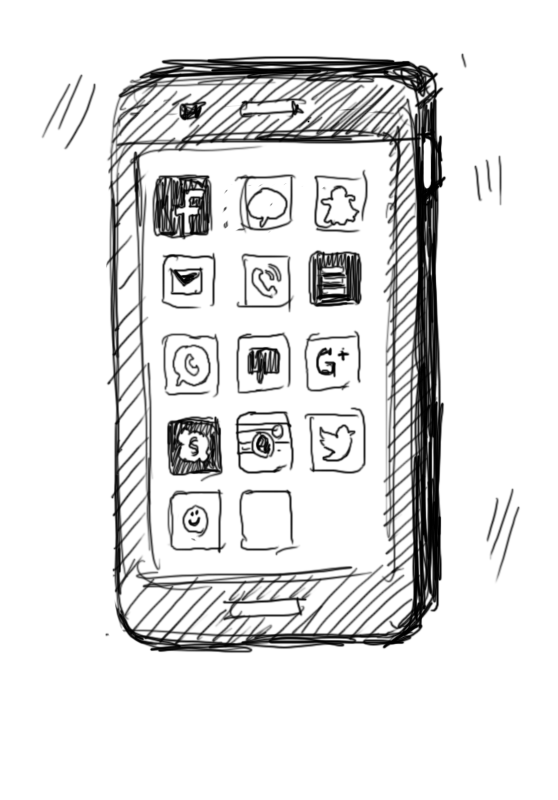This is the first part of ReadWrite’s four-part series on the future of messaging.
I was a teenage early adopter.
To me, it seemed like everyone else in my 8th grade class already had a cell phone when I got my first one a decade ago. But back then, only a third of American teens had sent a text message, according to the Pew Research Center. Three out of four teens, however, used instant messaging on their computers.
Fast forward a decade, and that percentage has neatly flipped. By 2012, 75% of American teens were texting, most of them daily, while only 22% used desktop-oriented instant messaging services on a daily basis.
In that same time frame, social networks have become ubiquitous, and to some oppressive. Broadcasting our daily activities to a hungry audience of casual online acquaintances isn’t something most people care to do. For them, messaging is a retreat to a safer, more intimate way of communicating.
Now texting is exploding—and fragmenting. Where we’ll end up a decade from now is just as hard to predict as the massive leap we took from 2004 to 2014.
Controlling the way we communicate is a valuable prize, as Facebook and Twitter’s large valuations reveal. If social networks, which fostered the idea of broadcasting our status, give way to more private tools like messaging apps, the very shape of the Internet landscape will be transformed beyond recognition.
Beyond Texting
I’m pretty sure my first text was “I finally got a cell phone.” When I got my megatrendy Nokia 3310 candybar-style phone with a Superman case, texting meant you have a cell phone, and having a cell phone meant you could text.

Messages are more than text, and more than phones. We now send messages using apps that add photos, videos, and other forms of communication while bypassing cell-phone companies’ networks.
And messaging has become a high-stakes business, with billions of dollars at play.
In the last few years, a handful of massively successful messaging applications—and even more copycats—have launched. They all aim to provide a better way to communicate privately, one that’s superior to both traditional text messaging and to older social networks like Facebook and Twitter. And they are made possible by the rise of smartphones and fast, cheap data networks around the world.
See Also: The 10 Most Popular Mobile Messaging Apps In The World
The most notable one is WhatsApp, a company that Facebook is in the process of acquiring for $19 billion, which now has more than 500 million users. WeChat, a messaging service developed by Chinese Internet giant Tencent, is closing in on WhatsApp with 438 million users. There are other contenders including Kik, a messaging and gaming app; Line, which filed for an IPO in July; Viber, acquired by Japanese e-commerce company Rakuten for $900 million; and the disappearing-message startup Snapchat, which Facebook has now tried to copy twice.
The Text To End All Texts?
All of them face the most formidable competition not in each other but in the Short Message Service protocol, or SMS—the standard for text messages used by cell-phone companies around the world.
The first text message was sent in 1992. Neil Papworth, a software engineer for the Sema Group in the United Kingdom, sat down and tapped out “Merry Christmas.”
In the United States, where wireless carriers were late to offer standardized text messaging, teens drove adoption. But in the rest of the world, texting was a way of avoiding wallet-draining phone calls. (In Europe and Asia, wireless customers typically pay by the minute rather than buying monthly buckets of minutes or unlimited plans, as we do in the States.)
In 1995 people were sending only 5 messages a year on average, through a limited set of wireless carriers. That number has skyrocketed. In 2012, people around the world sent 2 trillion text messages. That’s 333 for each person with a phone on the planet. Those messages cost almost nothing for carriers to transmit, but the senders typically pay a few pennies for each one, making it a lucrative business—one that messaging apps are eager to take a piece of.
Why Texting Isn’t Enough
Messaging is more than a business opportunity. It has deep meaning in our daily lives.
What makes messaging special—and drives us away from social media—is that messaging apps let us talk one on one, or with a small group. They give us a direct line of communication to people we care about. We can send a note that won’t get buried among a hundred other people’s updates in a news feed or timeline.
But how will we send those notes? That’s the critical question.
The inexorable rise of Facebook, and the concomitant decline of Myspace and Friendster, has led some to think that any app with social features is playing in a winner-take-all market. But that doesn’t seem to be happening in messaging.
Despite Facebook’s dominance, we’ve grown accustomed to using different social networks to manage our online identities—Facebook for friends, LinkedIn for work, and Twitter for news and information. That digital fragmentation will apply to private communications, too.
It’s easier than ever to build a messaging app, which can simply pull from our phone’s address books to populate a list of people to talk to. It’s not hard to keep up with multiple inboxes on a modern smartphone, where notifications tell us when we’ve got a new message.
Traditional SMS text messages won’t go away anytime soon. But what SMS lacks is precisely what gives messaging apps opportunities to grow. For many, texting still costs quite a bit of money. And it is restricted to 160 characters; you can send pictures and video on some services, but carriers haven’t worked out all of the kinks, and they’re aiming to charge even more for those extra. Texting may be the original mobile messaging service, but its shortcomings are painfully acute.

“Most of [these messaging apps] started as a cheaper alternative to SMS and other messaging formats,” said Forrester analyst Thomas Husson, author of the report Messaging Apps: Mobile Becomes The New Face Of Social. “They were created in the last two, three, four years and they leverage app platforms, like iOS or Android, successfully reach out to hundreds of millions of customers worldwide.”
Why Multiple Messaging Apps Will Thrive
I still use SMS, but not as frequently as I did when I was younger.
There are six main messaging applications in the “social” bucket on my iPhone. For the most part, I use Apple’s iMessage, which essentially hijacks the built-in texting service of your phone to send free messages over your data plan. I have two friends who only ever message me on Snapchat. Another prefers Google Hangouts. I rarely open Facebook Messenger—mostly when I forget how Facebook now pushes you into its standalone Messenger app when you’re on your phone. I find Twitter’s direct-message feature, which is in desperate need of a rumored upgrade, helpful for staying connected to people I only know tangentially through the Internet. I used to use Skype for work, though we dropped it for Slack, a service that’s designed to help teams communicate.
Because all these messaging apps require both the sender and recipient to have the same service installed, what ends up happening is that we all have different friends on different applications. Figuring out which messaging app to use is like moving to a new city and figuring out which neighborhood to hang out in. If you want to see all your friends, you’ll have to roam around.
My friends are not all alike. Some like sharing selfies from work that disappear after I’ve viewed them. Others prefer to send cute digital stickers, or voice-only messages which make me feel like a kid using walkie-talkies in the backyard.
Facebook Won’t Own Messaging The Way It Owns Social Networking
The shift from one-to-many communication, like Twitter and Facebok, to one-to-few, like WhatsApp and WeChat, is forcing startups and social giants alike to rethink their strategy.
Messaging apps are trying to take the basic human need for chatting with friends and family and turn it into something at once unique enough to draw interest, yet simple enough for the masses to adopt.
“Look at Facebook in particular and how they’re reacting to this WhatsApp acquisition, and the decision to not necessarily integrate that service into one single digital platform, but … create a constellation of apps,” Husson said. “More and more services are integrated into it—not like the one-size-fits-all social media app that Facebook used to be.”
The rise of Snapchat prompted Facebook to create a copycat called Poke that swiftly failed. Then it decided it might be better to buy than to build, snapping up WhatsApp, the world’s largest messaging app, for $19 billion.
It’s still gambling on building a disappearing-message service to rival Snapchat’s popularity, but its latest attempt, Slingshot, has slumped to No. 444 in the App Store for photo and video apps. Facebook’s disappearing-message app is what’s really disappearing.
Facebook is making many bets on messaging, though, from its own Facebook Messenger app to Instagram Direct, a tool for sending photos to a small group of people within the photo-sharing service, which normally broadcasts photos to the public like Twitter. On Android, Facebook Messenger takes over your regular texts, much like iMessage does on iPhones.
Before Facebook offered private messaging, users posted messages on each other’s profiles in an attempt to communicate. It’s clear that messaging is a crucial part of the Facebook experience. It’s just not clear that Facebook, even with WhatsApp in its arsenal, will own all of messaging.
The Fight Has Only Just Begun
Just like we use different social networks for different purposes, messaging apps will fill distinct needs.
What people want in a messaging app is the same thing we’ve wanted since we texted our first “Hello”: a way to privately connect with friends and family. Yo, a much-ridiculed app which lets you send just one word of acknowledgement to your friends, boils down that desire for connection to its purest essence.

There’s a lot riding on controlling how we talk to friends—just look at the billions companies are paying for messaging services.
But thanks to the pervasiveness of smartphones, and humans’ desire to connect with each other one on one or in small groups, messaging will only grow. And unlike in the world of social networks, where there’s unquestionable value in centralizing our activity, nothing will drive people to use just one app.
For the foreseeable future, we’ll live in a world where Snapchat lives alongside WhatsApp, where one-tap apps like Yo persist next to complex platforms for gaming and socializing like Line. Juggling multiple apps may be a mild aggravation for users like us. But if it means that no one company will control our most intimate communications, that seems like a tradeoff worth making.
Lead image by Anne Worner, illustrations by Nigel Sussman for ReadWrite










